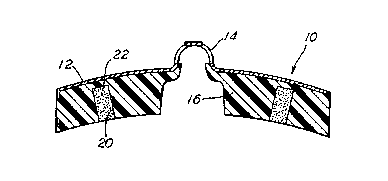Some of the information on this Web page has been provided by external sources. The Government of Canada is not responsible for the accuracy, reliability or currency of the information supplied by external sources. Users wishing to rely upon this information should consult directly with the source of the information. Content provided by external sources is not subject to official languages, privacy and accessibility requirements.
Any discrepancies in the text and image of the Claims and Abstract are due to differing posting times. Text of the Claims and Abstract are posted:
| (12) Patent: | (11) CA 2141720 |
|---|---|
| (54) English Title: | WHEEL TREAD CONDITIONING BRAKE SHOE |
| (54) French Title: | SEMELLE DE FREIN SERVANT AU REPROFILAGE A LA SURFACE DE ROULEMENT DE ROUES |
| Status: | Expired and beyond the Period of Reversal |
| (51) International Patent Classification (IPC): |
|
|---|---|
| (72) Inventors : |
|
| (73) Owners : |
|
| (71) Applicants : |
|
| (74) Agent: | MACRAE & CO. |
| (74) Associate agent: | |
| (45) Issued: | 1999-08-31 |
| (22) Filed Date: | 1995-02-02 |
| (41) Open to Public Inspection: | 1996-07-11 |
| Examination requested: | 1995-02-02 |
| Availability of licence: | N/A |
| Dedicated to the Public: | N/A |
| (25) Language of filing: | English |
| Patent Cooperation Treaty (PCT): | No |
|---|
| (30) Application Priority Data: | ||||||
|---|---|---|---|---|---|---|
|
A brake shoe for engagement with the tread of a
railway car wheel having a tread conditioning agent
incorporated in the composition friction brake shoe
material of the brake shoe block for altering the adhesion
between the wheel and rail on which the railway car is
guidably supported. The tread conditioning agent is a
material that is dissimilar from the composition friction
material of the brake shoe block, being chosen in
accordance with a lubricating quality or an abrasive
quality depending upon whether the brake shoe use is
intended to reduce or increase wheel/rail adhesion. In
either case, the chosen conditioning material has a wear
rate that exceeds that of the composition friction material
so that the degree of conditioning is controlled by the
wear rate of the composition friction material and the
percentage of brake surface of the brake shoe block
occupied by the conditioning material.
Note: Claims are shown in the official language in which they were submitted.
Note: Descriptions are shown in the official language in which they were submitted.

2024-08-01:As part of the Next Generation Patents (NGP) transition, the Canadian Patents Database (CPD) now contains a more detailed Event History, which replicates the Event Log of our new back-office solution.
Please note that "Inactive:" events refers to events no longer in use in our new back-office solution.
For a clearer understanding of the status of the application/patent presented on this page, the site Disclaimer , as well as the definitions for Patent , Event History , Maintenance Fee and Payment History should be consulted.
| Description | Date |
|---|---|
| Inactive: IPC from MCD | 2006-03-11 |
| Inactive: IPC from MCD | 2006-03-11 |
| Inactive: IPC from MCD | 2006-03-11 |
| Time Limit for Reversal Expired | 2006-02-02 |
| Letter Sent | 2005-02-02 |
| Letter Sent | 2003-02-25 |
| Grant by Issuance | 1999-08-31 |
| Inactive: Cover page published | 1999-08-30 |
| Inactive: Final fee received | 1999-05-20 |
| Pre-grant | 1999-05-20 |
| Notice of Allowance is Issued | 1998-12-16 |
| Letter Sent | 1998-12-16 |
| Notice of Allowance is Issued | 1998-12-16 |
| Inactive: Status info is complete as of Log entry date | 1998-12-07 |
| Inactive: Application prosecuted on TS as of Log entry date | 1998-12-07 |
| Inactive: Approved for allowance (AFA) | 1998-11-04 |
| Application Published (Open to Public Inspection) | 1996-07-11 |
| All Requirements for Examination Determined Compliant | 1995-02-02 |
| Request for Examination Requirements Determined Compliant | 1995-02-02 |
There is no abandonment history.
The last payment was received on 1999-01-27
Note : If the full payment has not been received on or before the date indicated, a further fee may be required which may be one of the following
Patent fees are adjusted on the 1st of January every year. The amounts above are the current amounts if received by December 31 of the current year.
Please refer to the CIPO
Patent Fees
web page to see all current fee amounts.
| Fee Type | Anniversary Year | Due Date | Paid Date |
|---|---|---|---|
| MF (application, 3rd anniv.) - standard | 03 | 1998-02-02 | 1998-01-21 |
| MF (application, 4th anniv.) - standard | 04 | 1999-02-02 | 1999-01-27 |
| Final fee - standard | 1999-05-20 | ||
| MF (patent, 5th anniv.) - standard | 2000-02-02 | 2000-01-20 | |
| MF (patent, 6th anniv.) - standard | 2001-02-02 | 2001-01-18 | |
| MF (patent, 7th anniv.) - standard | 2002-02-04 | 2002-01-18 | |
| MF (patent, 8th anniv.) - standard | 2003-02-03 | 2003-02-03 | |
| MF (patent, 9th anniv.) - standard | 2004-02-02 | 2003-02-03 |
Note: Records showing the ownership history in alphabetical order.
| Current Owners on Record |
|---|
| WESTINGHOUSE AIR BRAKE COMPANY |
| Past Owners on Record |
|---|
| BRUCE W. SHUTE |
| JOSEPH F. FORMOLO |